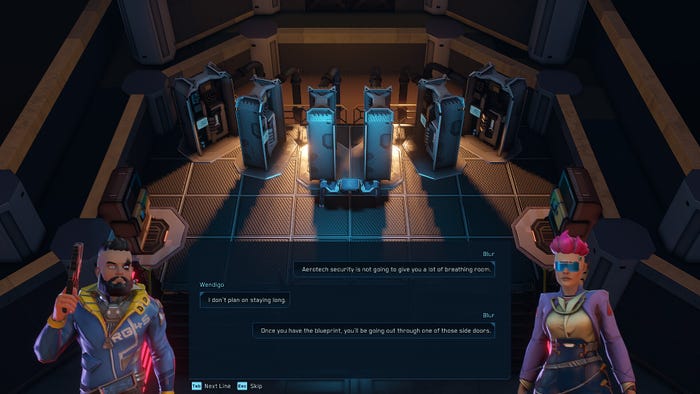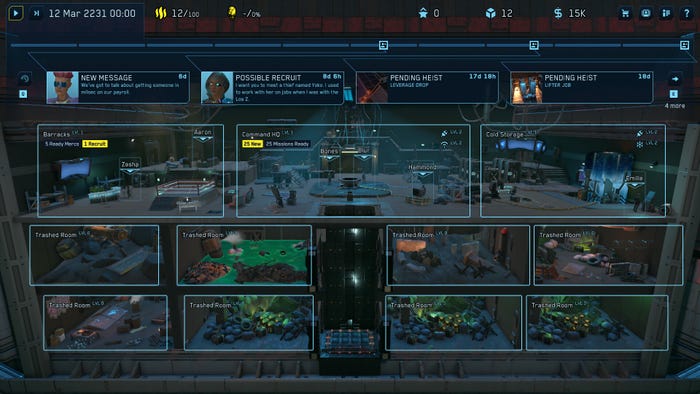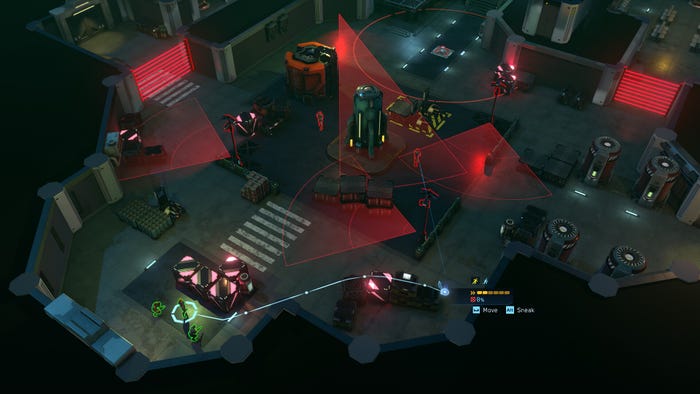Trending
Opinion: How will Project 2025 impact game developers?
The Heritage Foundation's manifesto for the possible next administration could do great harm to many, including large portions of the game development community.

Star Traders: Frontiers developer Trese Brothers (helmed by none other than...the Trese brothers, Cory and Andrew Trese) has built a niche for itself making games that deliver intensely complex systems on the back of modest combat mechanics and even more modest graphics. This week, the studio releases Cyber Knights: Flashpoint, a cyberpunk turn-based heist game that puts an emphasis on stealth and cribs the base building system of Firaxis' XCOM games.
It's a big leap forward for the brothers, who no longer operate as a two-person studio. Cyber Knights raised $226k on Kickstarter, which allowed the pair to bring on additional developers and retain the support of external dev partners like N-iX, Studio Viking and Novy Unlimited. The studio has also made the jump from 2D to 3D graphics, a carefully-considered step to expand what features can be added to make a cyberpunk stealth game feel more vibrant.
But Trese Brothers has made another major leap forward in its system-driven game design: as co-founder Andrew Trese told us last week, the studio developed a traits-driven system called "the Casting Director" to randomly advance a series of threaded stories for players' party members in a way that doesn't just make each run feel unique, but has a direct impact on the tactical gameplay of the game's high-stakes heists.
According to Trese, Cyber Knights' storytelling juggles a mix of hand-crafted and procedural elements, the latter being dictated by "the Casting Director." Between missions, the Casting Director is scanning the traits of different characters (referred to as "tags" by Trese), looking for ones to fulfill different scenarios.
"So if somebody takes a really bad wound on a mission...that storyline will go 'ooh, you're perfect for me, come with me.' Then a little while later that person is gonna be like 'I don't feel well...' and then you're stuck down a new path."
The system allows any of the game's unique characters to be dragged down the twists and turns of a set of generic questlines, but there are some specific to each character too. A character called "The Vanguard" has a specific story about her brother which can be activated by the Casting Director, and it can be modified based on the various traits she's acquired—and in turn, the results of that quest will modify other quests, and so on and so forth.

"It's very inspired by tabletop role-playing," he said, saying that he and his brother were trying to emulate cyberpunk tabletop role playing games they'd enjoyed when they were younger. Because cyberpunk games are often about criminals and mercenaries making frequent returns to a safe house after a job, a core trait of them is how players will manage their "pile of mercenaries" and all their life problems—baggage that an impact the outcome of a mission.
Trese compared building the Casting Director system to like playing Wube Software's Factorio. "We've got an input like 'this character gets shot—probably with a weird prototype weapon—and now he's sick and gets sucked into this storyline, and the storyline [may] resolve in a couple of different ways. He'll come out of it on the far side with new metadata attached to him saying 'he was wounded by this weird prototype nanoweapon, but he [was] surprised, and now he hates this corporation.'"
That metadata doesn't just reflect story traits—in the case of the wounded character, he'll now have a tactical trait indicating he's susceptible to other diseases from bioweapons. And now quests looking for a character susceptible to diseases—or ones who hate the corporation, or ones who've encountered the nanoweapon in question—know to grab that character and put him at the center of their stories.
An extremely scaled-back version of this system appeared in Star Traders: Frontiers, but it doesn't done with tags. He described it as a "search" of the game's database for characters of certain factions, of a certain "contact" type, and who the player has a high reputation with. Trese described the system as not terribly complex, and recalled that it was only certain instances of the system that were memorable.
He said he and his brother started to wonder if "half of" their next game's story could be written like that. "There are games that go 100 percent procedural...for the kind of game we're making I think we would lose something about what we're trying to say about the setting and characters if we went that far."
Testing this system was expectedly difficult, but Trese said it was helped by having a thousand of their Kickstarter backers pick up the various Alpha versions of the game to track down bugs. (That's one-fifth of their Kickstarter supporters by the way—an incredible conversion rate for any developer).

He said there weren't any hard rules could define the best parts of the system—all they could really do was ask when people played with it if their interactions felt good. The team chose not to build any systems internally that could randomly test the outputs because such a system would miss a vital part of the Casting Director—how the traits that impact the tactical missions feel in minute-to-minute gameplay.
There is one really unique function of the Casting Director system that stands out: how it handles "death." When characters die in a mission, they're moved into a "bin" referred to as the dead character bin.
If the Casting Director needs characters for a mission, it's able to check that bin for references—and use plot tools to "bring the character back to life," metaphorically speaking. For instance, a dead character might turn out not to be actually dead—just dragged off to prison and in need of rescuing by the player.
It's all heady stuff—a mix of procedural programming, improvisational logic, and deeply-buried rules intended to make the player look at their character traits and think beyond the numbers they represent.
Trese was excited about this system, but wanted to put it in some clear context. First, this system wasn't easy to create. "You have to deal with so many more kinds of permutations and randomness�—you really have to cover a lot of bounds that maybe you wouldn't have [had] to if you knew exactly what characters were going to be where and when."
Hanging this system on the architecture of a structured story—the same way a game master might keep players anchored on a core quest in a tabletop role-playing game—means that this method of interactive storytelling can't exist without old-fashioned narrative techniques.

And he really wanted to emphasize that the main reason the system feels good at all is because of the development time invested in non-narrative systems like combat, stealth, and even physics. The core tactical heists can be modified by changing some of the main parameters (which can be influenced by events that took place in the Casting Director), and once players are engaged with the turn-based stealth and combat, they're greeted with some unique mechanics that Trese says he hasn't seen in many other games.
"We have a very unique and fluid stealth and combat model," he explained. "I don't know anybody else who's doing...a turn-based strategy RPG where you an go in-and-out of stealth, and your relation to being in stealth is individualized to your character and enemies."
What he means is that if your character is spotted by one enemy, they're not instantly outed to all other enemies in the map. Another character might hear a noise from combat, or pick up an alert on the radio, but until they see where your unit is, they don't know where it's located. That is indeed a fairly unique mechanic, even from triple-A developers working in the stealth space.
Players can use that stealth system to their advantage, but also to counteract the negative traits picked up during the course of their campaign—and exploit the advantages granted by others. The tactical gameplay feeds back into procedural narrative, and the procedural narrative feels back into gameplay.
It's an interactive system that's just right for a cyberpunk game, once again showing off the systems-driven surprises that Cory and Andrew Trese are known for.
Read more about:
FeaturesYou May Also Like